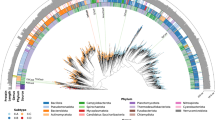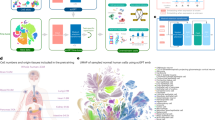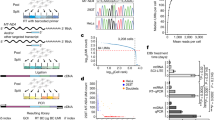Abstract
Several groups recently coupled CRISPR perturbations and single-cell RNA-seq for pooled genetic screens. We demonstrate that vector designs of these studies are susceptible to ∼50% swapping of guide RNA–barcode associations because of lentiviral template switching. We optimized a published alternative, CROP-seq, in which the guide RNA also serves as the barcode, and here confirm that this strategy performs robustly and doubled the rate at which guides are assigned to cells to 94%.
This is a preview of subscription content, access via your institution
Access options
Access Nature and 54 other Nature Portfolio journals
Get Nature+, our best-value online-access subscription
$29.99 / 30 days
cancel any time
Subscribe to this journal
Receive 12 print issues and online access
$259.00 per year
only $21.58 per issue
Buy this article
- Purchase on Springer Link
- Instant access to full article PDF
Prices may be subject to local taxes which are calculated during checkout


Similar content being viewed by others
Accession codes
References
Shalem, O., Sanjana, N.E. & Zhang, F. Nat. Rev. Genet. 16, 299–311 (2015).
Mohr, S.E., Smith, J.A., Shamu, C.E., Neumüller, R.A. & Perrimon, N. Nat. Rev. Mol. Cell Biol. 15, 591–600 (2014).
Xie, S., Duan, J., Li, B., Zhou, P. & Hon, G.C. Mol. Cell 66, 285–299.e5 (2017).
Adamson, B. et al. Cell 167, 1867–1882.e21 (2016).
Dixit, A. et al. Cell 167, 1853–1866.e17 (2016).
Jaitin, D.A. et al. Cell 167, 1883–1896.e15 (2016).
Datlinger, P. et al. Nat. Methods 14, 297–301 (2017).
Nikolaitchik, O.A. et al. PLoS Pathog. 9, e1003249 (2013).
Tseng, W.C., Haselton, F.R. & Giorgio, T.D. J. Biol. Chem. 272, 25641–25647 (1997).
Jetzt, A.E. et al. J. Virol. 74, 1234–1240 (2000).
Schlub, T.E., Smyth, R.P., Grimm, A.J., Mak, J. & Davenport, M.P. PLoS Comput. Biol. 6, e1000766 (2010).
Sack, L.M., Davoli, T., Xu, Q., Li, M.Z. & Elledge, S.J. G3 (Bethesda) 6, 2781–2790 (2016).
Yu, H., Jetzt, A.E., Ron, Y., Preston, B.D. & Dougherty, J.P. J. Biol. Chem. 273, 28384–28391 (1998).
el-Deiry, W.S. et al. Cell 75, 817–825 (1993).
Contente, A., Dittmer, A., Koch, M.C., Roth, J. & Dobbelstein, M. Nat. Genet. 30, 315–320 (2002).
Gasperini, M. et al. Am. J. Hum. Genet. 101, 192–205 (2017).
Han, K. et al. Nat. Biotechnol. 35, 463–474 (2017).
Lukoszek, R., Mueller-Roeber, B. & Ignatova, Z. FEBS Lett. 587, 3692–3695 (2013).
Yeganeh, M., Praz, V., Cousin, P. & Hernandez, N. Genes Dev. 31, 413–421 (2017).
Debnath, J., Muthuswamy, S.K. & Brugge, J.S. Methods 30, 256–268 (2003).
Sanjana, N.E., Shalem, O. & Zhang, F. Nat. Methods 11, 783–784 (2014).
Chen, B. et al. Cell 155, 1479–1491 (2013).
McKenna, A. et al. Science 353, aaf7907 (2016).
Dixit, A. Preprint at https://www.biorxiv.org/content/early/2016/12/12/093237 (2016).
Qiu, X. et al. Nat. Methods 14, 309–315 (2017).
Acknowledgements
We thank all members of the Shendure and Trapnell labs for feedback on our manuscript and helpful discussions, particularly S. Srivatsan, G. Findlay, A. McKenna, R. Daza, B. Martin, M. Kircher, D. Cusanovich, X. Qiu, and V. Ramani. We thank J. Bloom and D. Fowler for discussions about lentivirus, and K. Han, J. Ousey, and M. Bassik for experimental advice and reagents for CRISPRi experiments. A.J.H. thanks Stella the cat for support. This work was supported by the following funding: NIH DP1HG007811 and UM1HG009408 (to J.S.), DP2HD088158 (to C.T.), and the W.M. Keck Foundation (to C.T. and J.S.). A.J.H. and M.J.G. are funded by the National Science Foundation Graduate Research Fellowship. J.L.M. is supported by the NIH Genome Training Grant (5T32HG000035) and the Cardiovascular Research Training Grant (4T32HL007828). C.T. is partly supported by an Alfred P. Sloan Foundation Research Fellowship. J.S. is an Investigator of the Howard Hughes Medical Institute.
Author information
Authors and Affiliations
Contributions
A.J.H., J.L.M.-F., J.S., and C.T. devised the project. A.J.H., J.L.M.-F., L.M.S., and M.J.G. performed experiments. D.J. optimized cloning strategies and provided substantial technical support. A.J.H., J.L.M.-F., and J.P. performed analysis. K.A.M. provided critical input on mechanisms of template switching in lentivirus. A.J.H., J.L.M., J.S. and C.T. wrote the manuscript with input from other authors.
Corresponding authors
Ethics declarations
Competing interests
The authors declare no competing financial interests.
Supplementary information
Supplementary Text and Figures
Supplementary Figures 1–12 (PDF 9592 kb)
Rights and permissions
About this article
Cite this article
Hill, A., McFaline-Figueroa, J., Starita, L. et al. On the design of CRISPR-based single-cell molecular screens. Nat Methods 15, 271–274 (2018). https://doi.org/10.1038/nmeth.4604
Received:
Accepted:
Published:
Issue Date:
DOI: https://doi.org/10.1038/nmeth.4604
This article is cited by
-
Mapping the functional impact of non-coding regulatory elements in primary T cells through single-cell CRISPR screens
Genome Biology (2024)
-
Deep learning models to predict the editing efficiencies and outcomes of diverse base editors
Nature Biotechnology (2024)
-
Targeted CRISPR activation is functional in engineered human pluripotent stem cells but undergoes silencing after differentiation into cardiomyocytes and endothelium
Cellular and Molecular Life Sciences (2024)
-
CRISPR screening in hematology research: from bulk to single-cell level
Journal of Hematology & Oncology (2023)
-
In-organoid single-cell CRISPR screening reveals determinants of hepatocyte differentiation and maturation
Genome Biology (2023)



